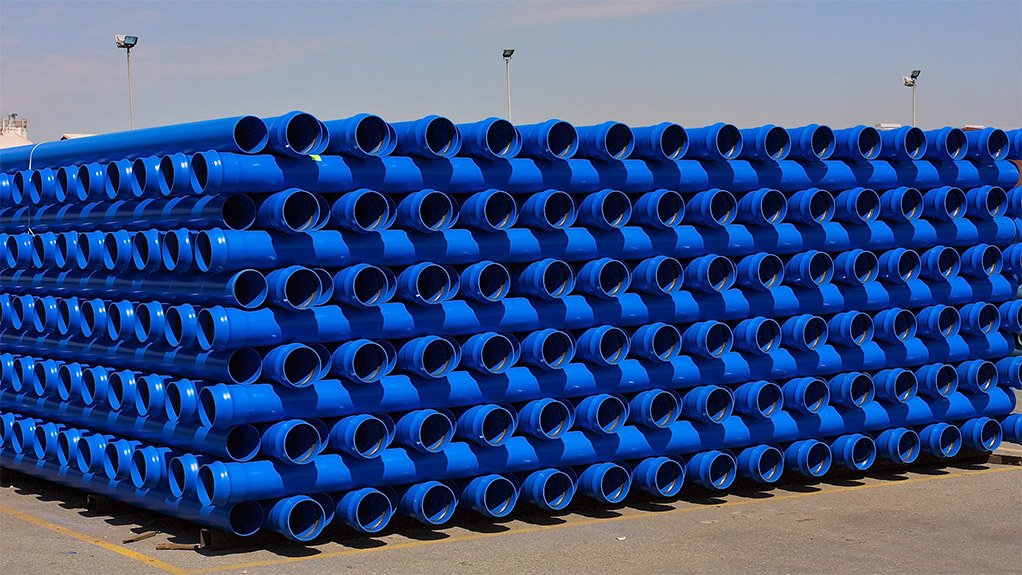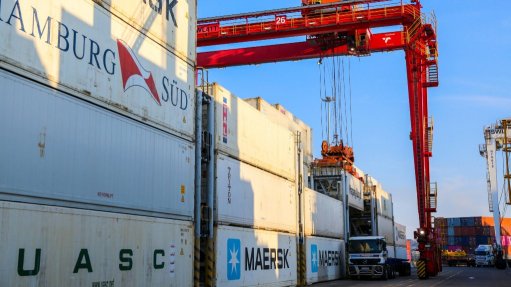Study finds plastic pipes have lowest environmental impact, energy costs



RECYCLING POTENTIAL Plastic pipes are being recycled on a large scale because of the high value of polymer used in the manufacturing process
LOCAL RECYCLING A recent Plastics SA report indicated 18 488 t of polyvinyl chloride was recycled in South Africa in 2014
When comparing manufacturing costs, long-term maintenance, transportation costs and recyclability of various piping systems, plastic pipes have come out on top, according to a recent study conducted by the Southern African Plastic Pipe Manufacturers Association’s (Sappma’s) technical committee.
The committee’s research comprised recently published results obtained from Europe and Australia, as well as the committee’s own calculations and research conducted by Sappma members. The aim of the study was to ascertain the environmental impact of plastic pipes, compared with pipes manufactured from other materials.
Highlighting the reason for the study, Sappma chairperson Jan Venter notes that the dramatic increase in the world’s population, compounded by industrialisation and urbanisation, has prompted pipes manufacturers to renew their efforts to make use of alternative energy sources on an economic and commercial scale.
“Piping systems are costly elements of infra-structure and it is therefore important to evalu- ate the energy costs associated with the produc-tion, operation and maintenance of plastic pipes,” he says.
Recyclability and Recovery
According to the latest plastics recycling figures released by Plastics SA last month, 18 488 t of polyvinyl chloride (PVC) were recycled in South Africa in 2014.
“The pipes and fittings industries represent the vast majority – 59% – of the local PVC industry. Our industry’s commitment and drive to ensure sustainable and safe manufacturing processes is, therefore, vitally important in terms of helping the local PVC industry set the bar in achieving their environmental targets,” says Venter.
He adds that plastic pipes are being recycled on a large scale because of the high value of polymer used in the manufacturing process. Although it is difficult to find old, unused pipe lying around that can be collected for recycling, a recent survey has shown that about 14 000 t of high-density polyethylene (HDPE) and PVC pipe was recycled at external facilities. In-house recycling by pipes manufacturers is estimated to be in the region of 8 000 t, bringing the total for these two pipe materials to about 22 000 t a year.
Venter further points out that, although ductile iron and steel pipes can also be recycled, the energy cost of doing so makes the process considerably more expensive than the recycling of plastics.
Basic calculations show that the cost of the power consumption required to recycle plastic pipe is about 9c, compared with between 23c and 45c for the cost of power consumption required to recycle steel. It is also important to note, says Venter, that many steel pipes are internally lined with a material that needs to be removed before recycling.
“Plastic pipes are not wasted and, therefore, they do not contribute to environmental pollution. A hundred per cent of recycled pipe can be reused, although Sappma’s strict quality requirements allow most of it to be used only in noncritical applications,” he says.
Calculating Energy Consumption
Venter notes that, to quantify and correctly assess the amount of energy used to manufacture a material or product, Sappma performed an embodied energy analysis, which involved assessing the overall amount of energy needed to extract the raw material, as well as manufacture and maintain the products.
The basic factors that influence the embodied energy of a piping system include the pipe size, type of material, durability and design life of the system, the amount of energy required to pump the fluid, the amount of maintenance required during its life span, the use of recycled material and the possibility of recycling the material after its useful life.
The results of the tests performed on the different types of pipes showed that, even though the material energy of ductile iron is a lot less than that of plastics, in terms of megajoules per kilogram, the amount reverses when the wall thickness and mass per metre are accounted for. Similarly, the amount of carbon dioxide (CO2) emitted in the production of plastic pipe is far below that of ductile iron, says Venter.
He explains that the results of local tests were supported by the findings of Europe’s Denkstatt study, titled ‘Plastics’ Contribution to Climate Protection’, which analysed the environmental impact of 173 products throughout their entire life cycle.
This study identified plastics’ contribution to citizens’ carbon footprint and provided a carbon life cycle analysis of plastics, compared with that of their alternatives in the packaging, transportation, building and construction sectors, as well as eco-product enablement, such as solar panels and wind turbines.
“While the carbon footprint of an average consumer amounts to about 14 t of CO2 per capita, a mere 1.3% (170 kg) stems from the use of plastic products. “The data shows that plastic saves 2.3-million GJ in energy every year. This equates to 50-million tons of crude oil – the size of 194 large oil tankers,” he says, adding that plastic products also prevent 120-million tons a year in greenhouse-gas emissions.
A similar study was recently completed in Europe, which showed that the pumping costs of plastic were also less than that of other materials.
“We are feeling the impact of energy shortages and high electricity costs acutely. “It is, therefore, vitally important to consider the amount of electricity used in the pumping of fluids through pipelines, as about 60% of the world’s electricity is used by electric motors, and 20% of this is used for pumping,” says Venter.
Owing to the specific properties of plastic pipes, the walls of the pipes offer limited resistance to flow, or low friction, and remain virtually unchanged throughout their design life. All this helps keep pumping costs down and saves money on maintenance in the long term.
Comparative calculations show that the increase in power or pumping costs after 50 years is only 13.6% for thermoplastics, compared with 62.6% for steel, concludes Venter.
Article Enquiry
Email Article
Save Article
Feedback
To advertise email advertising@creamermedia.co.za or click here
Comments
Press Office
Announcements
What's On
Subscribe to improve your user experience...
Option 1 (equivalent of R125 a month):
Receive a weekly copy of Creamer Media's Engineering News & Mining Weekly magazine
(print copy for those in South Africa and e-magazine for those outside of South Africa)
Receive daily email newsletters
Access to full search results
Access archive of magazine back copies
Access to Projects in Progress
Access to ONE Research Report of your choice in PDF format
Option 2 (equivalent of R375 a month):
All benefits from Option 1
PLUS
Access to Creamer Media's Research Channel Africa for ALL Research Reports, in PDF format, on various industrial and mining sectors
including Electricity; Water; Energy Transition; Hydrogen; Roads, Rail and Ports; Coal; Gold; Platinum; Battery Metals; etc.
Already a subscriber?
Forgotten your password?
Receive weekly copy of Creamer Media's Engineering News & Mining Weekly magazine (print copy for those in South Africa and e-magazine for those outside of South Africa)
➕
Recieve daily email newsletters
➕
Access to full search results
➕
Access archive of magazine back copies
➕
Access to Projects in Progress
➕
Access to ONE Research Report of your choice in PDF format
RESEARCH CHANNEL AFRICA
R4500 (equivalent of R375 a month)
SUBSCRIBEAll benefits from Option 1
➕
Access to Creamer Media's Research Channel Africa for ALL Research Reports on various industrial and mining sectors, in PDF format, including on:
Electricity
➕
Water
➕
Energy Transition
➕
Hydrogen
➕
Roads, Rail and Ports
➕
Coal
➕
Gold
➕
Platinum
➕
Battery Metals
➕
etc.
Receive all benefits from Option 1 or Option 2 delivered to numerous people at your company
➕
Multiple User names and Passwords for simultaneous log-ins
➕
Intranet integration access to all in your organisation




















